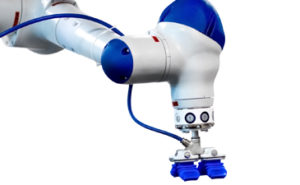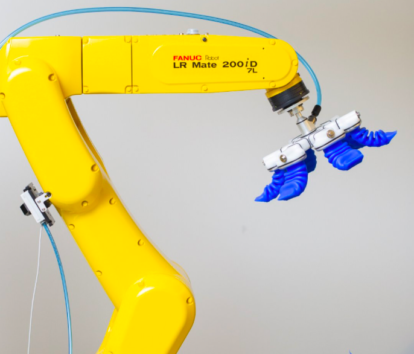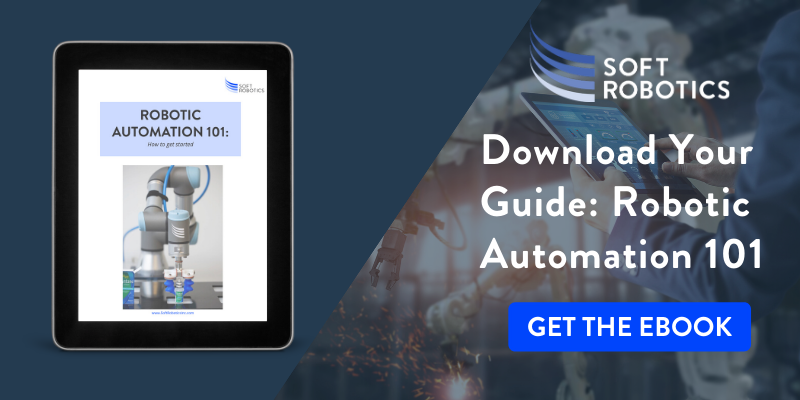
Collaborative Robots

Collaborative Robot
Robots range from teeny tiny microrobots to mega large industrial robots strong enough to lift cars. Somewhere in the middle there is a class of robots called collaborative robots or often referred to as cobots. Collaborative robots, much like in the name, are designed to work with humans to create, process or even design something. What makes them collaborative is that they can safely work alongside humans. They mimic the work of humans like picking, sorting or replenishing, minimizing downtime so humans can work more efficiently. The four major advantages of cobots are safety, space, easy programming and flexible and fast deployment.
1. Marketed as being safe, cobots are designed to be responsive to touch. Some are even cushioned with an external ‘skin’ allowing them to “feel” their surroundings in case of impact. If you were to bump into a cobot, it will pump the brakes and stop movement altogether, but not shut down completely. It could be a real deal-breaker if cobots didn’t have this feature.
2. This brings us to the second advantage of space. Because they’re safe to work alongside, they usually take up less than two square feet and depending on the application, safety caging is necessary to meet safety requirements. The footprint is just 1.6 sq ft standing alone consisting of a robot arm, vision system and an end-of-arm tool (EOAT). With just three components, cobots can be tasked with repetitive tasks leaving humans with more exciting jobs, like programming the friendly robot.
3. Even if you’re not familiar with robots, you can learn to program one. This means you can get a robot up and running on your own without having to rely on a third-party integrator, saving you on cost and time. For an untrained operator, they can unpack the robot, set it up and program their first simple task in less than an hour.
4. The fourth major advantage is flexible and fast deployment. Cobots are lightweight, space-saving and can easily deploy several different applications with no changeover. Moving a cobot around is easy as well as moving a cobot to a completely new process. Leave dirty, dangerous and dull jobs to cobots to reduce repetitive strain and most importantly, accidental injuries to humans.
To Cobot, or not to Cobot?
Cobots are designed to work with people handling tasks that are repetitive so human workers can focus on other tasks. The motivation for most automation investment is productivity and safety. If you’re looking to automate for an assembly operation, it’s worth exploring the different types of collaborative robots. With the right adaptable end-of-arm tooling (EOAT), you can get your automation up and running sooner. The mGrip adaptable gripper solution provides the flexibility and adaptability needed to handle SKU variation, conforming to new and changing productions in real-time. Because of this, we can now automate repetitive tasks in industries that haven’t been able to be automated, solving labor constraints and the risk of repetitive tasks. If you have an application that requires picking and placing at a higher speed, consider an industrial robot.
Ready to automate? Download our eBook for Robotic Automation 101 and start your automation journey.
Industrial Robots

Industrial Robot
Industrial robots, “the big boys”, or “the fast ones” have the advantages of speed and payload. They can operate at a higher volume and speed compared to cobots. Because they can perform dangerous, dirty and dull jobs with accuracy and consistency, industrial robots can be used in a range of industries. They can operate around the clock, 24 hours a day, 7 days a week, handling hazardous materials and in challenging environments. Humans benefit through the elimination of labor-intensive jobs that can cause potential physical strain or injuries to workers.
1. Industrial robots provide a variety of advantages and a major one is speed. Automation with industrial robots can almost double productivity. They can work at a constant speed without having to pause for coffee breaks, lunch or sleep. Ultimately, they can outperform jobs of any human worker in a shorter time and at a higher output.
2. The second major advantage of industrial robots is payload. It can lift a big range from 0.5 kg to 2300 kg. That’s the exact weight of the heaviest bony fish ever caught, the Mola alexandrine! The ability to handle products at this capacity is ideal for palletizing heavy parts, especially suitable for the automotive or metal industries. It can lift a whole car with no problem. While this is impressive, industrial robots are capable of handling a variety of items of different weight, shape, and size, from car doors to croissants. As fast and powerful as they are, they are also dexterous and gentle. Applications can range from pick and place to packaging, from raw foods to consumer goods. Because of this flexibility, robotic systems can be repurposed for other applications by swapping out end-of-arm tooling (EOATS) to accommodate different payloads.
Combining an industrial robot with the mGrip adaptable gripper, enables you to pick and place products at a much higher speed. Leveraging patented material science, our grippers can pick products without sensors, complex vision or numerical computation. Our application is easy to build and fast to deploy getting you up and running faster ever before. You can build production-ready grippers in minutes which can be reconfigured to help meet changing needs. Leave robotic work to robots and automate with a Soft Robotic gripper solution.
Are you ready to automate?
You know that robots can help you tackle those dull, dangerous and dirty jobs that are currently being done by human workers. And you also know that there is a labor shortage to fulfill these jobs. Consider robotic automation for your manufacturing operation and scale your operation. Whether you’re in the food, consumer goods or medical industry, the most obvious benefit is increased human and robot efficiency. If you don’t know how to navigate it, we’ve put together a step by step guide to get you started on your automation journey. It’s time to reduce the risk of injury, lower turnover rates and increase productivity. Download our eBook now to start growing your business.
